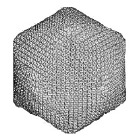Plant Pathology, Department of

James Van Etten Publications
Document Type
Article
Date of this Version
9-2014
Citation
Journal of Virology, December 2014, Volume 88, Number 23, pp. 13798–13810. doi:10.1128/JVI.02109-14
Abstract
The ubiquitin-proteasome system is targeted by many viruses that have evolved strategies to redirect host ubiquitination machinery. Members of the genus Chlorovirus are proposed to share an ancestral lineage with a broader group of related viruses, nucleo-cytoplasmic large DNA viruses (NCLDV). Chloroviruses encode an Skp1 homolog and ankyrin repeat (ANK) proteins. Several chlorovirus-encoded ANK repeats contain C-terminal domains characteristic of cellular F-boxes or related NCLDV chordopox PRANC (pox protein repeats of ankyrin at C-terminal) domains. These observations suggested that this unique combination of Skp1 and ANK repeat proteins might form complexes analogous to the cellular Skp1-Cul1-F-box (SCF) ubiquitin ligase complex. We identified two ANK proteins from the prototypic chlorovirus Paramecium bursaria chlorella virus-1 (PBCV-1) that functioned as binding partners for the virus-encoded Skp1, proteins A682L and A607R. These ANK proteins had a C-terminal Skp1 interactional motif that functioned similarly to cellular F-box domains. A C-terminal motif of ANK protein A682L binds Skp1 proteins from widely divergent species. Yeast two-hybrid analyses using serial domain deletion constructs confirmed the C-terminal localization of the Skp1 interactional motif in PBCV-1 A682L. ANK protein A607R represents an ANK family with one member present in all 41 sequenced chloroviruses. A comprehensive phylogenetic analysis of these related ANK and viral Skp1 proteins suggested partnered function tailored to the host alga or common ancestral heritage. Here, we show proteinprotein interaction between corresponding family clusters of virus-encoded ANK and Skp1 proteins from three chlorovirus types. Collectively, our results indicate that chloroviruses have evolved complementing Skp1 and ANK proteins that mimic cellular SCF-associated proteins.


Comments
Copyright © 2014, American Society for Microbiology. All Rights Reserved. Used by permission.